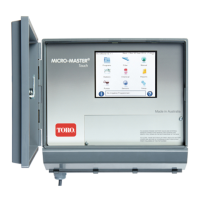Micro-Master Touch User Guide
139
© 2014 Toro Australia Pty Ltd Ver 1.2, June 2014
Figure 102 - Checking station current draw
With the meter in place, use the Manual Walk Through/Spot Water option to turn stations on in
sequence. Note the current and enter the values into the following commissioning sheet (see Table 1
) together with the wire colour (if a radio control valve then enter the Radio-Master for Touch
address). Then check the wiring and solenoids to any high current draw station. Valve boxes full of
water can create high current shorts across valve wiring joints during irrigation.
Suspect Station outputs
Whenever a station output is suspected of a malfunction, carry out the following tests.
Check field wiring and station currents and compare with the station current readings taken during the
initial commissioning.
Use the Manual Walk Through/Spot Water option to turn stations on in sequence, and check the
station voltage at the terminal. The station voltage must be over 24VAC to be a valid voltage. e.g.
if the voltage on an output terminal measured 7 - 16VAC, with a valve connected, then the result of
this test would indicate that there was an open circuit in the solenoid or a broken wire.
If more than one solenoid is connected to a station terminal, disconnect all but one solenoid and
check the station voltage across the station terminal. Repeat the test for each solenoid connected to
that terminal.
For the pump start wiring, a good practice is to operate a small relay (OMRON LY2 or equivalent)
which has a 24 VAC at 50mA coil and 240 VAC at 5 Amp contacts. These contacts can switch a
contactor with a 240 VAC coil of almost any size.
21.6
Voltage On Unused Pins
The 24VAC is a floating output. i.e. it does not have any reference to earth. The following readings

